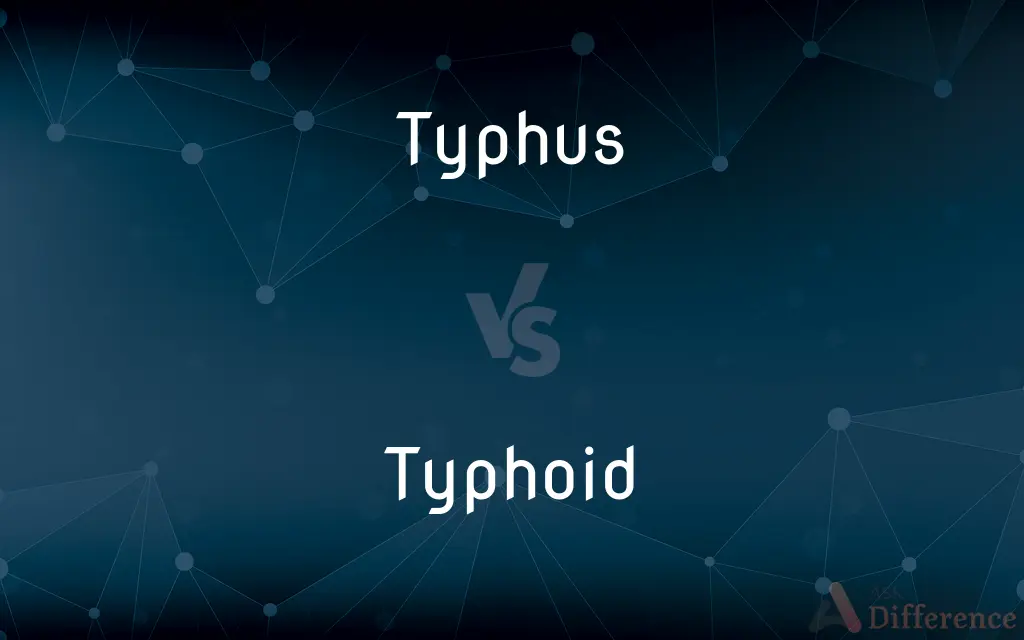Typhus vs. Typhoid — What's the Difference?
Edited by Tayyaba Rehman — By Fiza Rafique — Updated on September 28, 2023
Typhus is caused by Rickettsia bacteria spread by lice or fleas, while Typhoid is caused by the bacterium Salmonella Typhi and spread through contaminated food or water.

Difference Between Typhus and Typhoid
Table of Contents
ADVERTISEMENT
Key Differences
Typhus and Typhoid are both infectious diseases but are caused by different pathogens and transmitted in different ways. Typhus is a disease caused by bacteria from the Rickettsia family, transmitted primarily by lice, fleas, or mites. On the other hand, Typhoid is a disease caused by the bacterium Salmonella Typhi and is primarily spread through the ingestion of contaminated food or water.
Symptoms of Typhus include fever, headache, rash, and muscle aches. These symptoms are due to the infection of endothelial cells lining blood vessels. In contrast, Typhoid presents with symptoms such as sustained fever, abdominal pain, and occasionally a rash, resulting from the bacteria's invasion of the intestinal wall and subsequent bloodstream dissemination.
While both Typhus and Typhoid can be severe, they are treatable. Typhus is treated with antibiotics such as doxycycline, while Typhoid is commonly treated with antibiotics like ciprofloxacin or azithromycin, depending on the antibiotic resistance profile of the infecting strain.
Comparison Chart
Causative Agent
Rickettsia bacteria
Salmonella Typhi
Mode of Transmission
Lice, fleas, or mites
Contaminated food or water
ADVERTISEMENT
Common Symptoms
Fever, headache, rash, muscle aches
Sustained fever, abdominal pain, rash
Treatment
Doxycycline
Ciprofloxacin, azithromycin
Prevention
Avoiding lice and flea infestations
Vaccination, clean water, and food
Compare with Definitions
Typhus
Typhus is an infectious disease caused by Rickettsia bacteria.
Many soldiers during World War I contracted Typhus due to the unsanitary conditions.
Typhoid
Typhoid can be severe but is treatable with appropriate antibiotics.
Timely medical intervention can prevent the complications of Typhoid.
Typhus
Typhus can lead to severe symptoms, including high fever and rash.
If left untreated, Typhus can result in severe complications and even death.
Typhoid
Typhoid is a bacterial infection caused by Salmonella Typhi.
Travelers to certain countries are advised to get the Typhoid vaccine due to the high risk of infection.
Typhus
Typhus is transmitted primarily through lice, fleas, or mites.
Unsanitary living conditions can increase the risk of Typhus due to lice infestations.
Typhoid
Typhoid spreads through the ingestion of contaminated food or water.
Drinking untreated water in some regions can lead to Typhoid infection.
Typhus
Typhus outbreaks have historically been linked to wars and natural disasters.
The spread of Typhus after natural disasters is often due to the lack of clean water and shelter.
Typhoid
Typhoid fever presents with a sustained high fever and abdominal pain.
The persistent high fever associated with Typhoid can last for weeks if not treated.
Typhus
Typhus, also known as typhus fever, is a group of infectious diseases that include epidemic typhus, scrub typhus, and murine typhus. Common symptoms include fever, headache, and a rash.
Typhoid
Vaccination is a preventive measure against Typhoid.
The Typhoid vaccine offers protection against the disease for several years.
Typhus
Any of several forms of infectious disease caused by rickettsia, especially those transmitted by fleas, lice, or mites, and characterized generally by severe headache, sustained high fever, depression, delirium, and the eruption of red rashes on the skin. Also called prison fever, ship fever, typhus fever.
Typhoid
Typhoid fever.
Typhus
(pathology) One of several similar diseases, characterised by high recurrent fever, caused by Rickettsia bacteria. Not to be confused with typhoid fever.
Typhoid
Of, relating to, or resembling typhoid fever.
Typhus
A contagious continued fever lasting from two to three weeks, attended with great prostration and cerebral disorder, and marked by a copious eruption of red spots upon the body. Also called jail fever, famine fever, putrid fever, spottled fever, etc. See Jail fever, under Jail.
Typhoid
Characterised by or relating to typhus.
Typhus
Rickettsial disease transmitted by body lice and characterized by skin rash and high fever
Typhoid
Of or pertaining to typhus; resembling typhus; of a low grade like typhus; as, typhoid symptoms.
Typhus
Typhus can be treated with specific antibiotics.
Early diagnosis and treatment of Typhus can prevent severe complications.
Typhoid
Serious infection marked by intestinal inflammation and ulceration; caused by Salmonella typhosa ingested with food or water
Common Curiosities
Are there vaccines available for both?
There's a vaccine for Typhoid, but not for Typhus, although some specific types of Typhus have vaccines.
How is Typhoid spread?
Typhoid is spread through contaminated food or water, caused by the bacterium Salmonella Typhi.
Can Typhus and Typhoid be treated?
Yes, both Typhus and Typhoid are treatable with specific antibiotics.
How can I prevent Typhoid when traveling?
Get vaccinated, drink only bottled or boiled water, and avoid raw foods in high-risk areas.
What causes Typhus?
Typhus is caused by Rickettsia bacteria, transmitted by lice, fleas, or mites.
Are Typhus and Typhoid the same?
No, they are different diseases caused by different bacteria and transmitted differently.
What are common symptoms of Typhus?
Typhus commonly presents with fever, headache, rash, and muscle aches.
Is there a specific season for Typhus outbreaks?
Typhus outbreaks can occur anytime, especially in unsanitary conditions, but some types might have seasonal patterns.
Are Typhus and Typhoid fatal?
Both can be fatal if not treated, but with timely intervention, the prognosis is generally good.
Can you get Typhoid more than once?
Yes, previous infection with Typhoid doesn't grant lifelong immunity.
How long does a Typhus fever last?
With treatment, Typhus fever can last for about one to two weeks.
How is Typhoid diagnosed?
Typhoid can be diagnosed through blood tests, stool samples, and bone marrow samples.
Is Typhus linked to specific regions or conditions?
Typhus outbreaks are often associated with unsanitary conditions, wars, and natural disasters.
How long after exposure do Typhoid symptoms appear?
Typhoid symptoms typically appear 6-30 days after exposure to the bacteria.
Are there carriers for Typhoid?
Yes, some people can be carriers of Typhoid, carrying the bacteria without showing symptoms.
Share Your Discovery

Previous Comparison
Fuming vs. Mad
Next Comparison
Expert vs. VisionaryAuthor Spotlight
Written by
Fiza RafiqueFiza Rafique is a skilled content writer at AskDifference.com, where she meticulously refines and enhances written pieces. Drawing from her vast editorial expertise, Fiza ensures clarity, accuracy, and precision in every article. Passionate about language, she continually seeks to elevate the quality of content for readers worldwide.
Edited by
Tayyaba RehmanTayyaba Rehman is a distinguished writer, currently serving as a primary contributor to askdifference.com. As a researcher in semantics and etymology, Tayyaba's passion for the complexity of languages and their distinctions has found a perfect home on the platform. Tayyaba delves into the intricacies of language, distinguishing between commonly confused words and phrases, thereby providing clarity for readers worldwide.














































